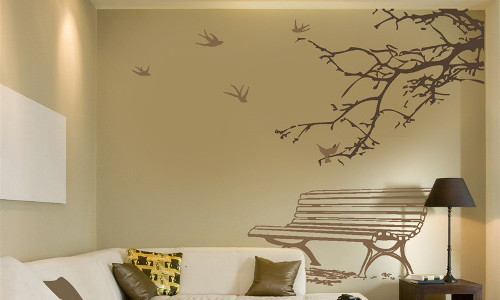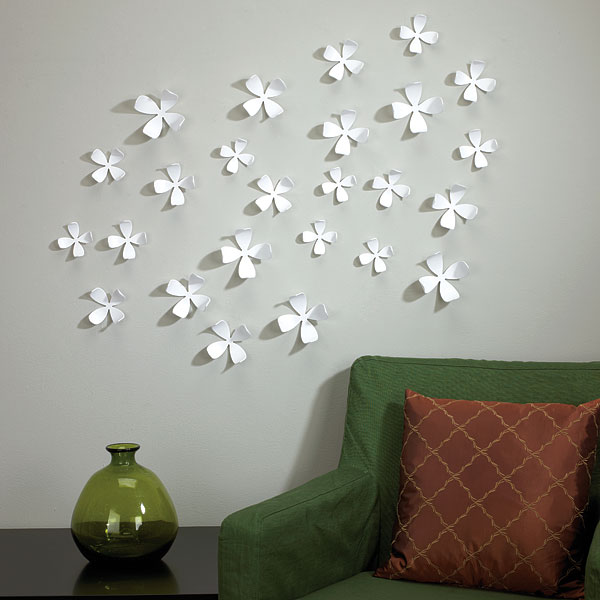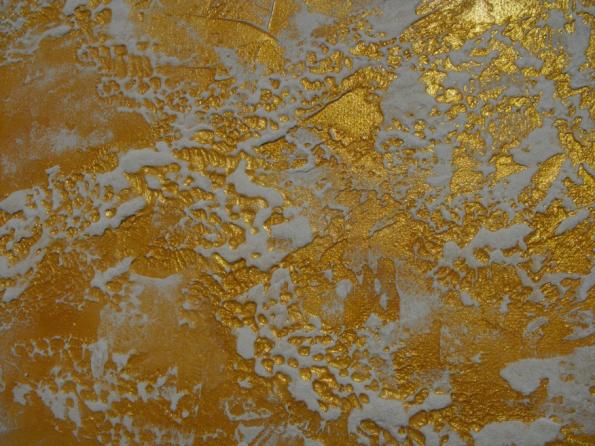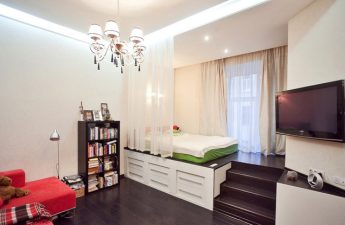For interior design, you can inviteprofessional designer, but it's much more interesting to do it yourself. To fully manifest the imagination and skill will help decorating the walls. Thanks to the abundance of available finishing materials, the design of the walls with their own hands does not take much time and will certainly bring a lot of pleasure. To the interior was moderately refined, original and unobtrusive, you should carefully choose the colors and think over the combination of materials.  Decorative painting of walls on stencils is accessible to everyone, the main thing is to choose colors and patterns that harmonize with the interior.
Decorative painting of walls on stencils is accessible to everyone, the main thing is to choose colors and patterns that harmonize with the interior.
Decoration with paints
The easiest way to decorate is staining. Using different colors and shades, you can give the room any atmosphere, visually reduce or enlarge the room, divide into zones, focus on a certain area. The use of the stencil will allow you to diversify the monophonic surface of the walls, add a touch. For residential premises, it is necessary to choose water-dispersion paints that are safe for health, quickly dry and have other advantages.  Picture 1. It is advisable to entrust the artistic painting of walls to a professional artist. The main condition for coloring is a flat surface, since the slightest defects appear through the paint. It is best to paint walls covered with plasterboard, but brickwork or concrete slabs should be leveled with several layers of plaster. To paint the paint more evenly, the walls are covered with a primer of deep penetration. In the process of work you will need:
Picture 1. It is advisable to entrust the artistic painting of walls to a professional artist. The main condition for coloring is a flat surface, since the slightest defects appear through the paint. It is best to paint walls covered with plasterboard, but brickwork or concrete slabs should be leveled with several layers of plaster. To paint the paint more evenly, the walls are covered with a primer of deep penetration. In the process of work you will need:
- paint brushes;
- roller;
- paint of different colors;
- plastic containers for paint;
- ready-made stencil.
Performing the design of the walls with their own hands, it followsThink about all the details: the color of the main background, the shade, the size and location of the picture, the presence or absence of edging. In the bedroom it is desirable to use gentle pastel colors and not too contrasting images; for the living room are more saturated colors, and for the children you can choose bright colored patterns on a light background. The image on the stencil is also of great importance. The figure should correspond to the general style of the room, therefore, for the classical interior, the image of exotic animals, ethnic ornaments or geometric figures is hardly suitable. The most original design of walls is an art painting, but only someone who can draw well can take it (photo 1).  Picture 2. Printing a pattern with a special roller is a simple and quick way to transform boring monochrome walls. One of the simplest variants of wall decoration with your own hands: having deviated from the top and from the lateral corners by 30-40 cm, paint the central part of the wall in a rich olive, claret or blue color. The remaining space is made 3-4 times lighter. Niches on a dark background are painted light, as well as areas around the door and window openings. Other design: the walls of the living room are painted in one color, and then in the most prominent corner, using a stencil, draw a large flower, a tree branch, an ornament or something else. If the living room is small, such a design of walls will fit: on a light background a small repeating pattern of white color. Apply it with a special roller (photo 2). And you can apply patterns not only vertically or horizontally, but also on the diagonal of the surface. You can divide the wall into segments and paint each of them in different colors, leaving the picture white. Or, on the contrary, change the color of the image and the main background. Back to contents</a>
Picture 2. Printing a pattern with a special roller is a simple and quick way to transform boring monochrome walls. One of the simplest variants of wall decoration with your own hands: having deviated from the top and from the lateral corners by 30-40 cm, paint the central part of the wall in a rich olive, claret or blue color. The remaining space is made 3-4 times lighter. Niches on a dark background are painted light, as well as areas around the door and window openings. Other design: the walls of the living room are painted in one color, and then in the most prominent corner, using a stencil, draw a large flower, a tree branch, an ornament or something else. If the living room is small, such a design of walls will fit: on a light background a small repeating pattern of white color. Apply it with a special roller (photo 2). And you can apply patterns not only vertically or horizontally, but also on the diagonal of the surface. You can divide the wall into segments and paint each of them in different colors, leaving the picture white. Or, on the contrary, change the color of the image and the main background. Back to contents</a>
Use of appliqués for decoration
 Photo 3.It is easy to make an applique on the wall yourself from cardboard or thick fabric. You can also decorate the walls in the living room with the help of applications. Now in stores they offer a large assortment that are mounted on wallpaper, plaster, wood or a painted surface. It is not difficult to make them yourself, using any materials at hand - office paper, tracing paper, cardboard, self-adhesive film, thick fabric. Volumetric applications, more often in the form of butterflies or flowers, have become very popular (photo 3). This wall design looks original and fresh, but it is done without much effort. For work you will need:
Photo 3.It is easy to make an applique on the wall yourself from cardboard or thick fabric. You can also decorate the walls in the living room with the help of applications. Now in stores they offer a large assortment that are mounted on wallpaper, plaster, wood or a painted surface. It is not difficult to make them yourself, using any materials at hand - office paper, tracing paper, cardboard, self-adhesive film, thick fabric. Volumetric applications, more often in the form of butterflies or flowers, have become very popular (photo 3). This wall design looks original and fresh, but it is done without much effort. For work you will need:
- colored paper;
- scissors;
- pencil;
- glue PVA or pins.
On paper draw contours of butterflies or flowers andcut out. If you can not draw beautifully, you can use the ready-made stencil. Thoroughly think over the location and shape of the composition and pencil marks on the wall. Then each figure is gently glued to the surface, creating the desired pattern. In a small living room, do not use a large number of applications and fill them with all the walls, in a spacious room, a complex pattern of many small elements will be quite appropriate. Back to contents</a>
Artistic plaster in the design of premises
 A photo 4. Textured decorative plaster perfectly masks small wall defects. Another demanded material for interior decoration is decorative plaster. With its help, you can create any texture, even without special knowledge. Due to its relief, the plaster perfectly masks small defects and uneven walls, which greatly simplifies the finishing process. For work you will need:
A photo 4. Textured decorative plaster perfectly masks small wall defects. Another demanded material for interior decoration is decorative plaster. With its help, you can create any texture, even without special knowledge. Due to its relief, the plaster perfectly masks small defects and uneven walls, which greatly simplifies the finishing process. For work you will need:
- primer;
- decorative plaster;
- acrylic paint;
- spatula, special grater or embossed roller;
- paint brush.
To make a high-quality wall design, firstyou need to practice on a small piece of plywood. It is not difficult to apply decorative plaster, but it is not so easy to create the desired texture. When forming patterns on the surface, the tool must be directed in the same direction, at the same angle - this way the pattern will be clearly visible. So, start by applying a primer. This increases the adhesion of the treated surface and protects it from moisture. When the wall is dry, knead the plaster and get to work. The solution is applied to a small section of the wall, carefully spreading with a spatula or other tool. The boundaries of the site should be blurred so that they do not shine through the new layer of mortar. After the decorative layer has dried, the surface is lightly sanded with fine-grained emery paper, wiped from dust, and then painted in the desired color. If painted first and then sanded, the protruding areas will contrast in color with the main background (photo 4). Using a dye for plaster has a certain effect. Having shown imagination, you can make the interior of your home exclusive without expensive materials and services of professional designers.


